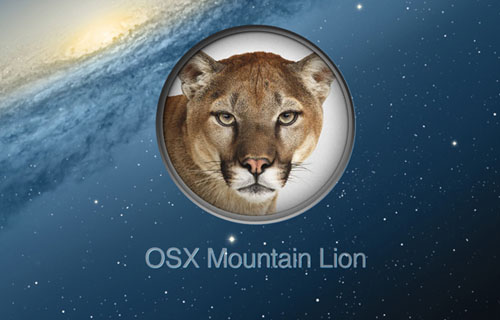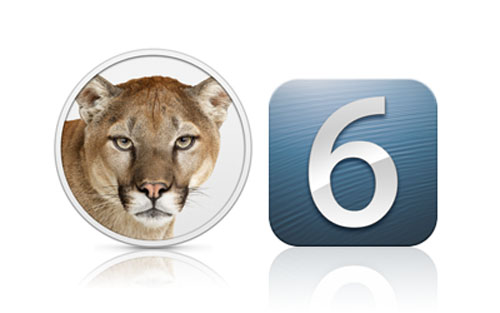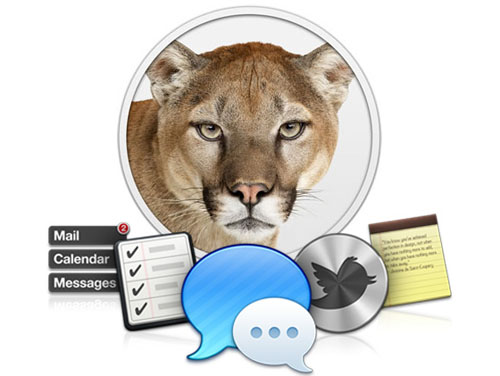-
Mac OS X 10.8 Mountain Lion–Everything You Should Know
Posted on August 23rd, 2012 No commentsMac OS X Mountain Lion 10.8 Review
Released in July 25, 2012, Apple OS X 10.8 Mountain Lion is the latest release of the world’s most advanced desktop operating system which aims to update your Mac into the best computing experience ever. The update is the first major Mac OS X upgrade for over a year, and aims to close the gap between Apple’s Mac OS X and iOS. Once installed, Mac OX X 10.8 Mountain Lion will deliver over 200 new features to Mac computers, including enhanced iCloud support, Facebook integration, iMessage support and voice dictation.
Main features in Mac OS X 10.8 Mountain Lion
Messages
● Send messages from your Mac to friends with an iPhone, iPad, or Mac.
● With iMessage, you can start a conversation on your Mac and pick it up on your iPhone or iPad.
● Messages also supports traditional instant messaging services like AIM, Yahoo! Google Talk and Jabber.iCloud
● Documents in the Cloud lets you create and edit your documents on your Mac, iPhone, and iPad.
● The new Reminders app makes managing tasks easy. Jot down your thoughts with the new Notes app. And iCloud keeps your Reminders and Notes up to date across all your devices.Safari
● Type both searches and Web addresses in the new Smart Search Field.
● Pinch to see tabs with Tab View and swipe to switch between them.
● iCloud Tabs makes the last websites you looked at accessible on your iPhone, iPad, and Mac.Notification Center
● New notifications appear in the top right corner of your screen.
● Open Notification Center from anywhere in OS X to see recent notifications.
● Configure your notifications to receive just the ones you want.Sharing
● Share links, photos, videos, and other files right from the app you’re in.
● Share with Mail, Messages, and AirDrop.
● Sign in to Twitter, Flickr, and Vimeo once to start sharing.
● Tweet right from your apps with the Tweet sheet.Game Center
● Play live multiplayer and turn-based games against friends on iPhone, iPad, iPod touch, or Mac.
● Log in to the Game Center app to see friends in your gaming network.
● Check out leaderboards and achievements.
● See what games your friends play and track your progress against them.Other great Mountain Lion features
● Dictation lets you talk anywhere you can type–no setup or training required.
● AirPlay Mirroring shows your Mac screen on your HDTV with Apple TV.
● Power Nap keeps your Mac up to date while it sleeps so it’s instantly ready to go.
● Gatekeeper makes it safer to download apps from the Internet by giving you control over which apps can be installed on your Mac.
● New features for Chinese users include improved text input, leading search engine Baidu as an option in Safari, sharing to microblogging service Sina Weibo and video websites Youku and Tudou, eight new fonts, and a new Chinese dictionary.More features can be found on Apple’s website
How does Mac OS X 10.8 Mountain Lion integrate with iOS?
Just like its predecessor, OS X Mountain Lion draws much inspiration from iOS, the operating system that powers the iPhone and the iPad.
1. iCloud, Integrated
Apple’s first real foray into the world of cloud computing (unless you count the ill-fated and soon- departed MobileMe) was iCloud, and it wasn’t released until October 2011, well after the release of OS X 10.7 Lion. Mountain Lion makes it much easier for iCloud users to sync documents between Macs and iOS devices. Mountain Lion-aware apps let you save documents to iCloud or your local system directly from the file system. If you save a doc to iCloud, any revisions that you make on one device are instantly available on all your other Apple devices. There’s a Documents Library for easy access to your iCloud documents, with the most recently used documents sorted to the top. Mail, Contacts, Calendars, Messages, Notes, and many more Apple apps and services work with iCloud in Mountain Lion, and there’s an API that will allow developers to create iCloud-enabled apps, too.2. iChat Is Dead, Long Live Messages
The extremely popular iMessage service has displaced the venerable iChat on Mountain Lion. The result is a cross-platform service that lets users on Macs, iPhones, and iPads chat with each other. It allows for unlimited messaging, including the sending of high-quality photos, HD video, and attachments as large as 100MB. Mac users will want to restrain themselves when chatting with friends on metered mobile data plans, although the iOS version of the app is smart enough to route messages through Wi-Fi when it’s available. Messages shows delivery receipts by default, and there’s also an option to turn on read receipts. Messages are encrypted end to end, and there’s a button to escalate your chat to a FaceTime video call. Messages works with other instant-messaging services, including AIM, Google Talk, Jabber, and Yahoo.3. Game Center Now Playing on Mac
Game Center has made the move from iOS to Macs. If you don’t know it from iOS, Game Center is a social gaming platform. Looking for a new game or someone to game against online? This is where you’ll do it on your Mac. You’ll be able to play against anyone with a connected iPad, iPhone, or Mac, too. Game Center enables multiplayer games, in-game voice chat, and notifications of friend requests and game invitations. There will be an API for Game Center that lets developers leverage in-game chat, leaderboards and more.4. AirPlay Mirroring Makes Your TV an Apple Television
If you’ve got an Apple TV device on the same network as your Mac (with a second-generation Intel Core processor), Mountain Lion makes it simple to mirror your screen on your HDTV (at 720p resolution). AirPlay Mirroring pops up to let you know when it detects an Apple TV, and it handles all the resolution matching. Combined with Game Center, AirPlay Mirroring can more or less turn your Mac into a game console.5. New Notification Center
Mountain Lion unifies system and app messaging, giving all messages a consistent look and bringing them into one place. The Notification Center slides in and out from the right-hand side of the screen when you use a new trackpad gesture (a two-finger swipe from the right edge). Or you can click the Notification Center button in the upper right corner of the screen. (It turns blue when there are new notifications.) Apps can pop up banners, which last on your screen’s upper right corner for five seconds before moving into the notifications center. Alerts, on the other hand, pop up and persist until dismissed. There’s an API for developers, too, so that their apps can appear in the Notification center and conform to the Mountain Lion style.6. Share Sheets
Mountain Lion-enabled apps get Share Sheets. Press the share button from within the app and you get a menu (a “sheet”) of services for sharing links, pictures, videos, etc. At the preview stage, we saw links for AirDrop (to share directly to Macs on your network), email, Flickr, Message, Twitter, and Vimeo. (Facebook isn’t available in the initial release of Mountain Lion, but word is it’s coming soon.) The share button is baked in throughout the system: Safari is a no-brainer, but it’s a little cooler to find out that anything you can preview or QuickLook can pop up a Share Sheet. There’s a developer API for Share Sheets, too, so third-party apps can also get in on the sharing action. Twitter gets special mention. Click Twitter on a Share Sheet and you get a “Tweet Sheet” that contains whatever it is you’re tweeting about: link, picture, etc, with the usual character countdown. Once you’ve got Twitter set up, it gets added to the Notification Center, by default.7. Reminders Reach the Mac
The Reminders app you know from iOS—the same one that works with Siri on iPhone 4S and has geo-location reminder abilities – is now available for your Apple desktop. This simple organizational app keeps you on track with lists, due dates, and sorting by date. Apple iCloud can keep it synced across all your devices, and it also works with CalDAV services, such as Google Calendar and Yahoo Calendar (though you can keep local-only reminder lists, too).8. Take Note of Notes
Mountain Lion takes another page from iOS and pulls Notes out of email, promoting it to its own app. Notes can be fairly rich, content-wise; you can drag and drop photos and attachments to Notes and format them with bullets, fonts, numbered lists, and so on. You can pin Notes to your desktop with a double click, and the Share button makes it easy to send them to collaborators. Finally, with iCloud, all your Notes are synced across all your Macs and iOS devices.9. Gatekeeper Keeps Mountain Lion Safe
Mountain Lion beefs up security with Gatekeeper, a powerful line of defense against future threats. Gatekeeper prevents malware by only running apps it deems safe because (at Gatekeeper’s most restrictive setting) you downloaded them from the Mac App Store, or (by default) because they were downloaded from the App Store or written by licensed Apple developers and contain digital signatures that are destroyed if hackers modify the code. There is a third setting you can choose, too, that will let you run apps downloaded from anywhere. Apple will provide digital signatures to every registered developer for inclusion in their software, so by the time Mountain Lion ships, most safe apps should be signed.10. One More Thing: China
Apple has a chance to get some positive China-related coverage for a change with its OS X 10.8 Mountain Lion one more thing: A big push for improved Chinese localization. And why not? It’s a huge market, and Apple CEO Tim Cook revealed earlier this year that Mac adoption in China doubled last year versus 2010. New features include improved text input, for example, with better suggestions for Chinese characters, and typing for English and Chinese characters without toggling between the two for more convenient input of names or words without Chinese equivalents. Apple also promises to more than double the number of Chinese characters supported in handwriting recognition, auto-correction, and improved text input for those who type Pinyin with regional pronunciations. Apple also gives a nod to local services: Users will also be able to set up Mail, Contacts, and Calendar with services like QQ, 126, and 163. Also planned is Baidu search in Safari, as well as access to Chinese social-network site Sina weibo and video sites Youku and Tudou via share sheets.Why you should choose Mac OS X 10.8 Mountain Lion?
With the new Messages app you can send text, photos, videos, contacts, Web links, and documents to anyone using another Mac, iPhone, iPad, or iPod touch — you can even start a conversation on one device and continue it on another. The new Share button makes it easy to share files, Web pages, photos, and videos, as well as tweet right from the app you are using. With the Reminders app you can create to-do lists and alerts that appear in the new Notification Center. With Notes you can write down all your ideas and even speak your words with voice dictation. Play head to head games on your Mac with friends on their Macs or iOS devices with Game Center. And with iCloud built in, it’s simple to keep all your mail, contacts, calendars, reminders, notes, to do lists, music, photos, iWork files, PDFs, and more up to date across all your devices.
How and Where to Get?
Unlike previous iterations of the operating system users won’t be able to buy the software on disc or USB, and will instead have to pay $19.99 to download the update from Apple’s Mac app portal.
Getting it is a cinch. Open the Mac App Store OSX, just a couple of clicks away from purchase. It installs right over the top of your current version. It’s wise to make a complete backup of your system before you go ahead with the upgrade. If you do that with Time Machine, it’s easy to roll back to your previous operating system if something goes wrong.How to upgrade to Mountain Lion?
Step 1: Make sure your Mac can run Mountain Lion
Not all Mac owners will be able to upgrade. Mountain Lion won’t be compatible with Macbooks dated pre-2007 or a Mac Mini from before 2009. Your Mac must be one of the following models:
● iMac (Mid 2007 or newer)
● MacBook (Late 2008 Aluminum, or Early 2009 or newer)
● MacBook Pro (Mid/Late 2007 or newer)
● MacBook Air (Late 2008 or newer)
● Mac mini (Early 2009 or newer)
● Mac Pro (Early 2008 or newer)
● Xserve (Early 2009)Step 2: Make sure you have Lion or the latest version of Snow Leopard
If you are running Lion (10.7.x), you’re ready to update to Mountain Lion. Go to Step 3. If you are running Snow Leopard (10.6.x), update to the latest version of OS X Snow Leopard before you purchase OS X Mountain Lion from the Mac App Store. Click the Apple icon and choose Software Update to install Snow Leopard v10.6.8, the latest version.Step 3: Download OSX Mountain Lion from the Mac App Store
Open the Mac App Store from your Dock to buy and download Mountain Lion. Then follow the onscreen instructions to install it.займ на карту rusbankinfo.ru
Apple news Mac OS X 10.8 Mountain Lion, Mountain Lion features, Mountain Lion iOS, Mountain Lion review





Recent Comments